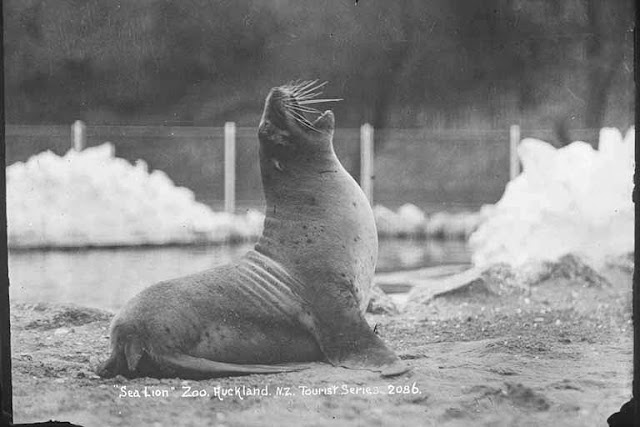Leopard Seal Bones in the Dargaville News
Reading through last week's Dargaville & District News (1 February 2011), I came across this fascinating article about the bones of a Leopard Seal (Hydrurga leptonyx) that were being put together for display at the Kumara Box Theatre in the township. According to the founder Barry Searle he had discovered the bones jutting out of a sand dune on Ripiro Beach. He had removed them then had stored them under his house in a plastic bag. It was estimated, according to the article, that the bones had possibly been in the dune for at least 100 years. It fascinated me enough, to go looking into other historic incidences where these Antarctic range animals have been found in places in northern New Zealand, other than their own habitat. Leopard Seals have a vast range. They are large animals with predatory behaviours, they are known to attack human beings if provoked. From time to time they do appear on New Zealand coastlines further north than normal.
 |
| Sir George Grey Special Collections, Auckland Libraries, AWNS-19090916-4-1 |
In September 1909 a large adult sea leopard came ashore at Stanmore Bay on the Whangaparoa Peninsula. It appears that the animal was sadly shot. The Auckland Weekly News image (16 September 1909) shows the Leopard Seal propped up with a small piece of wood the jaws keep apart with a stick lodged into the mouth.
|
..A sea-leopard, 11ft 3in in length, is reported by the Auckland Star to have come ashore at Stanmore Bay, Whangaparoa.
Wanganui Herald 20 September 1909
 |
| Sir George Grey Special Collections, Auckland Libraries, 35-R163
In 1927 the residents of Karekare beach on the west coast of the Auckland Region, found themselves facing a formidable adult Leopard Seal, with sharp teeth and an aggressive attitude. Not discouraged by the challenge,the Karekare residents got together and lassoed the animal. They towed it on a sledge to a stable and locking it up over night. The next day it was taken to the Auckland Zoo as a gift from the residents of Karekare Beach. I found the above image of the Leopard Seal on the Auckland Libraries website Heritage Images On Line.
A fine specimen of a sea leopard was captured on the Karekare Beach on Monday. The animal was found on the beach, and, when approached showed fight. It was lassooed round the head and tail, and then, despite violent struggles, it was sledged to the boarding-house, where it was accommodated in the stable for the night.
The animal was accepted as a gift from the Karekare residents for the Auckland Zoo, and yesterday it was brought by motor-lorry. to its new home, where it soon settled down peacefully with other marine exhibits. The sea leopard is seven feet in length, and a beautiful soft grey colour, interspersed with black spots. It it is a very rare visitor to such a high latitude as Karekare.
Evening Post 12 October 1927
|
Antarctic Leopard Seal Image Sourced: Wikipedia Commons.
The Leopard Seal is listed on the IUCN Red List as being of least concern due to its wide range. Its diet includes penguins and other seals. If you do see one alive on a Northland Beach, then do the right thing and leave it well be. If in doubt get hold of the nearest Department of Conservation representative. It is against the law in New Zealand to interfere with marine wildlife. Better to be safe than sorry and end up seriously injured or worse dead.
The Leopard Seal is listed on the IUCN Red List as being of least concern due to its wide range. Its diet includes penguins and other seals. If you do see one alive on a Northland Beach, then do the right thing and leave it well be. If in doubt get hold of the nearest Department of Conservation representative. It is against the law in New Zealand to interfere with marine wildlife. Better to be safe than sorry and end up seriously injured or worse dead.




Comments
Post a Comment